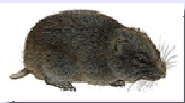 Lemmings are animals of legendary cultural status, inspiring a wide range of myths, music, films, a chess move and, of course, an extremely popular series of computer games. This article aims to reveal the animal behind the myth, focusing on one species in particular: the southern bog lemming (Synaptomys cooperi).
Lemmings are animals of legendary cultural status, inspiring a wide range of myths, music, films, a chess move and, of course, an extremely popular series of computer games. This article aims to reveal the animal behind the myth, focusing on one species in particular: the southern bog lemming (Synaptomys cooperi).The southern bog lemming, like all lemmings, is a type of rodent. It has a large round body with a relatively small head and a very short tail measuring just two centimeters (slightly less than an inch). They have brown fur, which provides superb camouflage in the undergrowth in which they live. Interestingly, their undersides are a light silver colour. They weigh in at about 35 grams (1.2 ounces) when adult and grow to about 13 centimeters (just over 5 inches) in length.
Southern bog lemmings are found in North America and in the northern part of their range they are sympatric with the northern bog lemming (the only other species in the genus Synaptomys). The habitat of the southern bog lemming includes grasslands, wetlands and forests. They are herbivorous with a diet consisting of mosses, grass and fungi. With all the green vegetation in their diet it is perhaps not hugely surprising that the droppings of the southern bog lemming are green. Birds of prey, weasels and snakes all see the southern lemming as a particularly appetising meal.
Contrary to common belief lemmings are not suicidal. There are in fact other cases in the animal kingdom where suicide has proven to be evolutionary adaptive, however, this does not seem to be the case with lemmings. The myth of lemming suicide arose from a Disney film, which showed lemmings marching off a cliff to their deaths. Further investigation revealed that the lemmings filmed (not in this case southern bog lemmings) were actually actively launched off the cliff using a turntable. In the wild, lemming populations go through boom and bust cycles spanning a period of about four years (including the southern bog lemming and in common with many other species of rodent). At the point in this cycle when overpopulation occurs, large numbers of lemmings will migrate in search of new territories. Occasionally large groups of migrating lemmings may reach a cliff and some may be forced over the edge by the marching hoard of lemmings behind them. However, even this scenario is uncommon.
Keywords: brown , tail , green
The Southern bog lemming is listed as Least Concern (LR/lc), lowest risk. Does not qualify for a more at risk category. Widespread and abundant taxa are included in this category, on the IUCN Red List of Threatened Species
Some facts about the
Southern bog lemming
Adult weight : 0.027 kg (0.0594 lbs)
Gestation : 23 days
Weaning : 23 days
Litter size : 3
Litters per year : 3
Weight at birth : 0.003 kg (0.0066 lbs)
Weight at weaning : 0.02 kg (0.044 lbs)

Custom Search